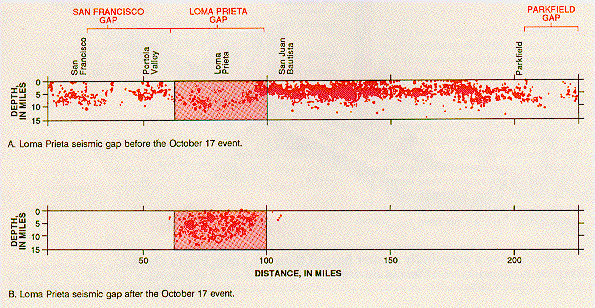

This figure shows a cross section of earthquake activity along the San Andreas fault in Northern California, from Parkfield to San Francisco, projected onto the plane of the San Andreas fault.
A: Activity from January 1969 to July 1989. Note how there seem to be ``gaps'' in the activity, where few or no earthquakes occurred, around Loma Prieta, the San Francisco peninsula, and just South of Parkfield.
B: The Loma Prieta earthquake and the first three weeks of aftershocks. The frenetic burst of activity associated with this major earthquake neatly filled in most of the Loma Prieta gap.
(This figure, along with the other two Loma Prieta illustrations used in these web pages, is digitized from a USGS pamphlet: ``The Loma Prieta Earthquake of October 17, 1989'', by Ward and Page, printed by the US government printing office in 1989.)
The ``seismic gap'' theory postulates that over the long run all parts of the fault must average about the same level of movement per time. This can either happen through the cumulative efforts of a very large number of very small earthquakes, as appears to happen between Parkfield and San Juan Bautista, or through much rarer larger earthquakes, as happened for the part of the fault around Loma Prieta. A large and longstanding ``seismic gap'' is usually interpreted to mean that a significant earthquake should be expected.
To assign a risk to a given stretch of fault, scientists attempt to estimate the ``slip deficit'' along it, and if records exist compare this to how often it has broken in the past (to get an idea of how much stress it can stand before breaking). At best such simpleminded theories can only give rough estimates, though. The Parkfield gap has had a history of breaking about every 22 years, almost like clockwork. As a result it was widely expected to break sometime in the mid 1980's. In preparation the USGS has made that section of the San Andreas the most heavily instrumented stretch of fault on Earth.
But... here it is 2002 and still no big earthquake! Sort of a seismological version of ``a watched pot never boils''!